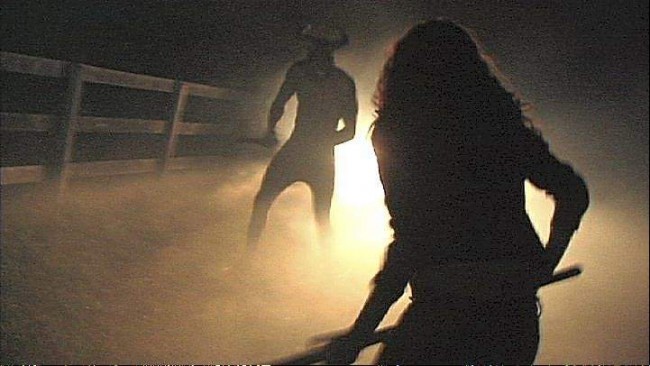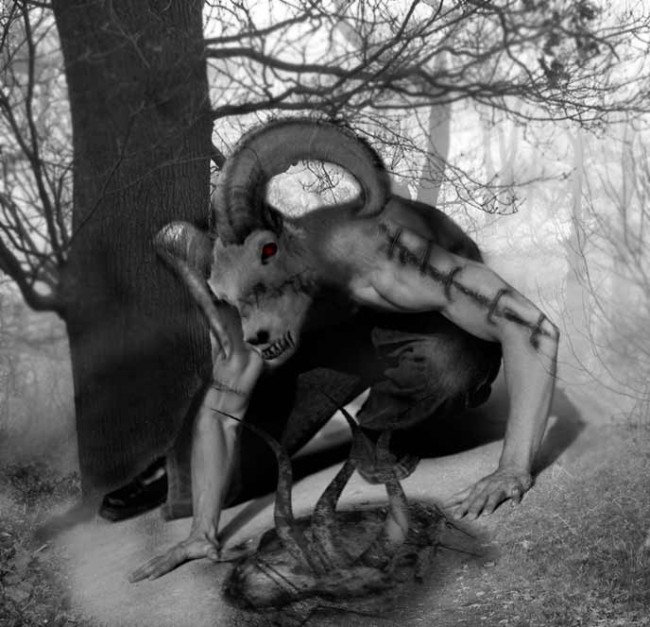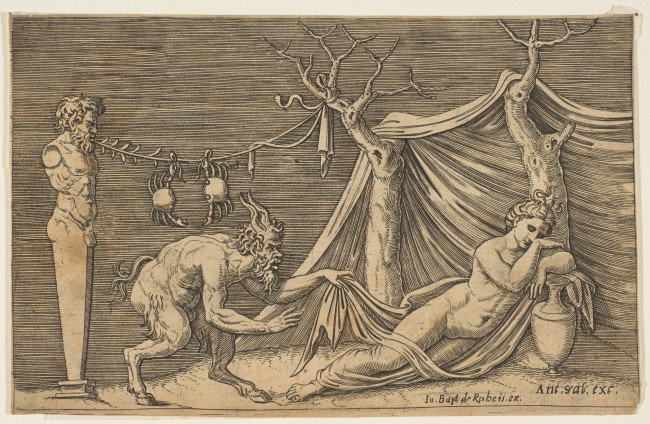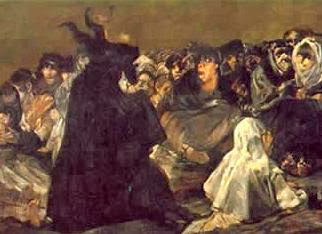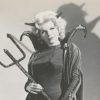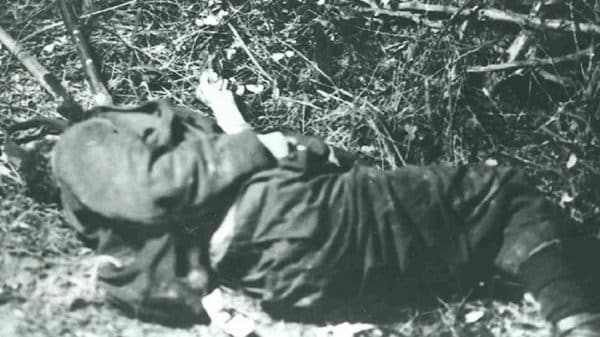Imagine this – a young couple drives out to some deserted road. It is a spot that people call “lover’s lane”. They park the car and turn out the lights. Then suddenly, without any warning, a great hairy thing rushes out of the woods and begins beating on the windows and doors of the car. For a moment the couple are too surprised and terrified to do anything. Then the driver starts the car, and drives away as fast as he can. Over the roar of the motor the couple can hear the monster screaming in rage.
– Daniel Cohen, Monsters You Never Heard Of
For generations, teenagers have been frightened by cautionary tales of the shadowy beings that haunt the secluded wooded areas on the outskirts of town. An intimate evening spent parked along an old country road could very well attract the unwelcomed company of restless ghosts, hook-handed madmen, or strange and unknown creatures. Or so the legends go.
Among the most timeless and terrifying of these abstinence-inducing creatures of the night is The Goatman – a large, hairy, hoofed, and horned monster that has been ruining romance all across North America since at least the 1950s, and throughout history going back to ancient times.
For decades, eyewitnesses have reported seeing a fearsome creature described as being half-man, half-goat in several localities of Prince George’s County, Maryland. Strange footprints, home invasions, property destruction, animal mutilations, missing children, and unexplained car accidents have all been blamed on ‘The Goatman’.1 But it’s his terrifying late-night sexual interventions on unsuspecting teenagers that he is most infamously known for.
The first reported sighting was made in August 1957, when two witnesses claimed to have been attacked by the creature in the Forestville-Upper Marlboro area. The young couple was spending an evening parked at a local make-out spot, near a dark wooded area just off the street. They were startled by a loud banging on their car hood and looked up to see a large, hairy, horned creature with a double-bladed ax in its hand. The creature glared menacingly at the couple before fleeing into the woods2 A few nights later, a man and his wife who lived nearby reported seeing a “hairy wild-man” going through their trash.3 Following these frightening encounters, members of the Upper Marlboro fire department and some local hunters organized a search of the area for this “Abominable Phantom” but turned up nothing. Additional sightings were reported in the following weeks, but authorities eventually declared the whole thing to be a hoax.4 A few years later, a young couple were romantically involved in their car, just off Zug Road, in Huntington, when they observed a peculiar creature staring at them from the edge of the woods. The woman described it as a “tall, ragged animal with human-like features.”5
The legend of The Goatman grew throughout the 1960s. Teenagers were warned against parking in wooded areas at night, or else they risked a run-in with this ax-wielding beast. Sporadic sightings and encounters continued. Strange tracks turned up. Pets occasionally went missing. And a lot of good campfire stories were shared. But eventually, The Goatman’s boogeyman grip over this community began to fade into distant memory.
However, by the early ’70s, the monster came back with a vengeance, once again raising his ugly horned head and resuming his reign of terror over Prince George’s County. In April 1971, a farmer near Fletchertown Road, in Huntington, reported seeing “a large, man-like creature” eating the remains of a pig. When he approached the scene, the creature ran off. In November of that year, in the town of Bowie, a 16-year old girl was awakened in the middle of the night by her dog barking. When she looked out her window she saw a large hairy creature walking upright and moving towards her tied-up dog. Frightened, she retreated back in her room and called for help. Two neighbors, armed with baseball bats, chased the creature into woods where it disappeared into the night (giving off a “high-pitched squeal” while retreating). They returned to find the dog’s severed head on the ground, with the rest of the carcass apparently taken by the creature. The story was picked up by The Washington Post and the legend was given new life.6

In 1973, a man was driving along Rt. 32 reportedly saw a “huge beast on two legs with glowing eyes”.7 A few years later, a woman reported seeing “a grayish-brown, round-shouldered animal with reflective red eyes” cross the road in front of her car on Route 198 and then step over the guard rail and disappear. And in April 1977, a NASA engineer witnessed a “Bigfoot-type creature” tossing a dog onto the road at I-95 and Powder Mill Road in Beltsville.8 Over the next decade there were numerous reports of The Goatman attacking cars, attacking dogs… and attacking cars with dogs (throwing dogs off overpasses along stretches of Interstate 495 seems to have been a favorite pastime during the ’80s). And as recently as 2000, construction workers claim to have come face to face with “a 300-pound, seven-foot-tall furry creature” that had “the legs, hooves, and horns of a goat, but the upper-body of a man” near the town of Bowie.9
So what is The Goatman? Is he just an old scare story used by parents to keep hormone-laden teenagers in check, or is there something more to it?
There are a number of theories regarding his identity and origin. Many people believe that he is, or was, nothing more than an ornery old hermit, clad in fur skins and armed with an ax, who claimed the back roads of Prince George’s County as his own personal domain and had territorial issues with the local youths. Others believe it is an undiscovered woodland creature, a horned cousin of Bigfoot maybe. There are the various mad scientist theories that revolve around the U.S. Agricultural Research Center in Beltsville, Maryland (one version claims geneticists created a hybrid man-goat, which then escaped the facility and took up residence in the nearby forest; another involves a genetic experiment going horribly wrong, transforming a once mild-mannered Bruce Banner scientist into a hairy, horned Hulk-like beast). Similar stories involve the Glenn Dale Hospital, an old tuberculosis sanitarium, where local legend has it that a patient was experimented on and left mutilated and deformed before escaping into the woods.10 And then there is the god-fearing Christian folk who believe he is no less than the Devil himself.
A few hundred miles to the west of Prince George’s County is another goat-horned beast. The Pope Lick Monster is said to haunt the area around an old train trestle in Jefferson County, Kentucky, just outside of Louisville. Sightings of the monster go back to the 1950s when some boy scouts were chased from their camping spot on the banks of the Pope Lick River by a screaming beast that threw rocks at them. Like the Maryland Goatman, this Kentucky cousin is known to attack young couples who trespass in his domain and has been blamed for mysterious livestock mutilations that have occurred on farms in the surrounding area.11 Additionally he is said to be responsible for a number of deaths by teenagers who have jumped from the 100-foot high trestle, using “either hypnosis or voice mimicry to lure trespassers onto the trestle to meet their death before an oncoming train”.12
In Fort Worth, Texas, there is the Lake Worth Monster. The first known sighting of this creature occurred in the summer of 1969, when John Reichart, his wife, and two other couples were parked at Lake Worth late one night and “a truly vile and monstrous-looking creature came storming out of the thick branches of a large, nearby tree”. The horned monster was said to be covered with “scales and fur” and left behind a deep scratch across the side of the car as they fled the scene. Police investigated the area of the attack but turned up nothing. The Forth Worth Star Telegram’s headline the following day read “Fishy Man-Goat Terrifies Couples Parked at Lake Worth” and the local monster hunt was on. That evening the creature was seen running across a stretch of road close to the Lake Worth Nature Center. Shortly after a group of would-be vigilantes chased the Goatman through the woods and up a rocky bluff. The panicked creature tossed an old car tire down at his pursuers, who quickly retreated to safety.13 Sporadic sightings continue.
Residents of Washington County, Wisconsin, have lived with Goatman legends that supposedly date back to the mid-19th century. The original story goes that a returning Civil War veteran was traveling with his new bride in a horse-drawn wagon along the desolate Hogsback Road when an axle broke. He left his companion with the wagon while he went off for help. After hours of waiting, the bride was startled by the sound of something sniffing and growling outside the wagon. She peeped out and was terror-stricken to see “a dark, hairy creature with the body and head of a goat, but walking upright like a man.” She hid in the wagon until the monster appeared to be gone, and then ran off in the direction of her husband. She followed the footprints through the mud until she eventually came across his bloodied body hanging from a tree that was surrounded by hoof prints. Ever since then it’s said that the Goatman preys on hapless drivers who get stranded on Hogsback Road… and they’re never seen again.14
Sightings and encounters with large, hairy, horned man-creatures have also been reported in Alabama, Arizona, Arkansas, California, Florida, Indiana, Louisiana, Michigan, Missouri, Oregon, Washington, and as far north as Ontario, Canada.15
There is a thinking in primordial images, in symbols which are older than the historical man, which are inborn in him from the earliest times, eternally living, outlasting all generations, still make up the groundwork of the human psyche.
– C. G. Jung, Modern Man in Search of a Soul
Gods suppressed become devils, and often it is these devils whom we first encounter when we turn inward.
– Joseph Campbell, Thou Art That: Transforming Religious Metaphor
The stories surrounding The Goatman combine the best elements of cryptozoology, folklore, and urban legend. But even more interesting is just how far back through history, and across how many different cultures, encounters with “goat men” have been taking place. The Goatman can be seen as something of a mythological archetype, representing both primal nature and untamed sexuality. From the horned shamanic gods of early hunter-gatherer societies to the black goat demons that haunt the superstitious Christian mind, the concept of a supernatural horned being has been universally present in the collective consciousness throughout human history.
The male goat, because of its reproductive prowess, has been seen as a symbol of virility, sexual potency, stamina, and creative energy in many cultures. For this reason, goats have maintained a cult following (literally) that goes back to the ancient societies of Mesopotamia, who both worshiped horned gods and used male goats in their fertility rituals.16 In ancient Egypt, the people of Mendes (the Greek name for the ancient city of Djedet) worshiped Ptah, the creator and fertility god who was sometimes depicted with the head of a goat and the body of a human. Male goats were considered holy to the Mendesian mystery cult, and women worshipers were said to copulate with them in public fertility rituals.17 Likewise in the ancient Indian sub-religion of Kaumaram there is the goat-headed god Naigamesa, worshiped as a fertility god (specifically in granting sons to infertile women) and, dualistically, feared as a demon who abducted and injured children.18
As sexuality was often inter-connected with nature, so too was the goat. The goat gods and nature spirits were seen as lords over the wild, chaotic and dangerous side of the natural world. And in many folk traditions, they were thought of as both trickster and hunter gods, combining mischievous and cunning characteristics with sometimes violent and predatory tendencies. Pan – the god of nature, fertility, sexuality, and hunting in Greek mythology – has often been referenced alongside The Goatman legends. He was depicted as a wild hairy creature, with the horns and cloven hooves of a goat, and a “primal lust” that was insatiable. Like most nature gods, he had a dark side too: Pan The Hunter and Pursuer. As protector of the wilderness, he was prone to violence at times, attacking those who passed through his realm without warning. Ancient Greek shepherds also believed that when their herds suddenly scattered in fear without apparent reason it was Pan who frightened them (this is where the word “panic” comes from).19
Dionysus (sometimes called “he of the black goat” and “the nocturnal one”) was another horned god in the Greek pantheon, representing fertility, intoxication, and ecstasy. Like Pan, this god also had a dualistic dark side. Underneath the light-hearted revelry often associated with Dionysus was a bi-polar personality of savagery, madness, and the destructive forces of nature. The cults who worshiped him were known for their frenzied dances, drunken orgies, and acts of sparagmos – a form of ritual sacrifice where animals, most often goats, were mangled and dismembered and the raw flesh consumed.20
The goatish wild nature spirits who served Pan and Dionysus were known as satyrs. Part human and part bestial, they were commonly represented as having bristly hair, upturned noses, pointed ears, horse-like tails, and the horns of a goat.21 Wild, drunk, lewd, and possessing an unbridled libido, they roamed the remote mountainous and wooded glens, on the eternal prowl for nymphs (and occasionally mortal women) to procreate with. During Roman times, the satyr became conflated with the faun – a half-human, half-goat follower of the pagan nature deity Faunas (often referred to as the Roman Pan). Like the satyrs, the fauns were considered “place spirits” of the untamed forests and inspired fear in men traveling in lonely, remote or wild places.22
Veles was a horned nature god in Slavic paganism. Originally known as the “master of the forest” in the neolithic era, he presided over the souls of wild animals that were killed by hunters. In later eras, he was the god of harvest, horned animals, death, and the underworld. He was also known as a trickster god and associated with music and magic. Like all horned pagan gods, Veles eventually became identified with the Devil when the Slavs became Christianized during the Middle Ages.23 Further east, in Chinese folklore, there was Yang Jing, a goat-like nature god who ruled over the remote and sparsely settled mountainous regions. Peasants would make sacrifices to him to protect their livestock and harvests against predators and worshiped him as a god of fertility and sexual potency.24
Horned gods and spirits appear often in Celtic folkloric traditions. Cernunnos is one of the horned gods that date back to prehistory (as evidenced by the “dancing shaman” in the Trois Freres cave painting, in southern France). He was worshiped by the Celts as the “lord of wild things” or “master of the hunt” and, in addition to being the protector of the untamed natural world, also represented male virility, sexual prowess, and power;25 The Glaistig was a forest goddess in both the Scottish Highlands and Ireland who was said to have the upper half of a woman and the lower half of a goat, and known to throw stones at travelers and lead them astray from their paths; In Irish folklore, there were the Bocánach, goat-horned spirits that haunted battlefields who would make high pitched shrieks at night; and the Púca were shape-shifting goblins, often appearing as goat-like creatures, that resided in the rural areas of Wales and Ireland who were believed to tear down fences, attack livestock, trample crops and generally do damage around remote farms (many farmers would leave a small portion of the season’s harvest in the fields as “púca’s share” to placate the hungry creatures).26
In the Jewish tradition is the story of The Watchers, the fallen angels who were cast out of heaven. In the Book of Enoch, the leader of The Watchers is Azazel, and the fallen angels around him are referred to as seirim, or “he-goats”. These goat demons walked the earth at night, lusting after women and spreading sin among men.27 Like the Jews before them, the Christians would vilify the worship of pagan gods – particularly deities associated with nature and fertility. In the Gospels, Jesus compares sinners to goats, proclaiming: “Depart from Me, accursed ones, into the eternal fire which has been prepared for the devil and his angels”.28 By the 11th century, depictions of demons and devil figures started to take on goatish features, usually appearing naked and hairy to symbolize sexuality, wildness, and animality.29 During the witch-hunts it was not uncommon for accused witches, under forced confession by church officials, to claim to have communicated or copulated with the Devil in the guise of a goat (often described as “filthy, stinking and black”) while engaging in rituals that were reminiscent of ancient Dionysian and Panic rites.30
There are also the Native American traditions that speak of “skinwalkers” – individuals with the supernatural ability to transform themselves into various animal entities, including coyotes, wolves, bears, crows… and goats. In traditional Navajo culture, the yenaaldlooskii (“with it, he goes on all fours”) is a type of skinwalker who, like the werewolf of European traditions, attains their shape-shifting powers through black magic. In bestial form, the yenaaldlooskii is said to dig up graves, steal livestock, attack people, and even commit murder.31 A goat-like skinwalker is mentioned in Quechan native legends and has been used by generations of parents to scare children into not wandering around the reservation after nightfall.32
Back in Maryland, the Piscataway tribe once worshiped (and feared) “Okee”, a shape-shifting spirit described as a “monstrous-looking devil” who roamed the dense forests.33 Could this be the original Goatman of Prince George’s County?
Mark Laskey
http://illuminating-shadows.blogspot.com
——–
FOOTNOTES
1. Ed Okonowicz, Monsters of Maryland: Mysterious Creatures in the Old Line State (Mechanicsburg, PA: Stackpole Books, 2012), 118.
2. “Legends & Folklore: The Maryland Goatman,” Strange News Daily, Web, www.strangenewsdaily.net.
3. Washington Evening Star, August 5, 1957.
4. Sean Daly, “The Legend of Goatman,” Washington City Paper, September 18, 1998.
5. “The Maryland Goatman Legend,” Phantoms & Monsters: Pulse of the Paranormal, Web, www.phantomsandmonsters.com.
6. Mark Opsasnick & Mark Chorvinsky, “Still on the Trail of the Goatman,” The Strange Report #14.
7. “The Maryland Goatman: Urban Legend or Experiment?,” Cryptozoo-ocity, Web, http://cryptozoo-oscity.blogspot.com.
8. Andrew Gable, “Urban Legends of Maryland, Part II: Goatman,” Masks of Mesingw, Web. http://masksofmesingw.blogspot.com.
9. Mack Maloney, “Your State’s Weirdest Unexplained Phenomenon,” TruTV, Web. www.trutv.com.
10. “Legends & Folklore: The Maryland Goatman,” Strange News Daily, Web. www.strangenewsdaily.net.
11. Eric Grundhauser, “Pope Lick Trestle Bridge,” Atlas Obscura, Web, https://www.atlasobscura.com/places/pope-lick-trestle-bridge.
12. Ibid.
13. Nick Redfern, Memoirs of a Monster Hunter (Newburyport, MA: New Page Books, 2007), 179-182.
14. Linda Godfrey, Strange Wisconsin: More Badger State Weirdness (Milwaukee: Big Earth Publishing, 2007), 38.
15. Rob Morphy, “The Goatman,” American Monsters, October 12, 2010, Web, http://www.americanmonsters.com.
16. Linda Kalof, Looking at Animals in Human History (London: Reaktion Books, 2007), 14.
17. Ernest Budge, The Gods of the Egyptians: Or, Studies in Egyptian Mythology, Volume 2 (London: Methuen & Co, 1904), 353.
18. Asim Kumar Chatterjee, The Cult of Skanda-Karttikeya in Ancient India (Calcutta: Punthi Pustak, 1970) 106-07.
19. Patricia Merivale, Pan the Goat-God: His Myth in Modern Times (Cambridge, MA: Harvard University Press, 1969).
20. John Coughlin, Out of the Shadows: An Exploration of Dark Paganism and Magick (Bloomington: 1st Book Publishing, 2002), 158-59.
21. R.F. Willetts, “Satyrs,” in Man, Myth & Magic: An Illustrated Encyclopedia of the Supernatural, vol. 18 (Singapore: Marshall Cavendish Corp, 1970), 2481.
22. Luke Roman, Encyclopedia of Greek and Roman Mythology (New York: Fact on File, 2010), 172.
23. John McCannon, “Veles,” Encyclopedia Mythica, Web, https://pantheon.org.
24. G. Rodney Avant, A Mythological Reference (Bloomington: AuthorHouse, 2005), 135.
25. Avant, 37-38.
26/ Montague Witzel, “Cernunnos: The Celtic Horned God,” Isis Books, Web, https://store.isisbooks.com/Cernunnos_s/400.htm.
27. William Butler Yeats, Fairy and Folk Tales of the Irish Peasantry (London: Walter Scott Publishing, 1890).
28. Richard Cavendish, “Goat,” in Man, Myth & Magic: An Illustrated Encyclopedia of the Supernatural, vol. 8 (Singapore: Marshall Cavendish Corp, 1970), 1121.
29. Matthew 25:41, “The Sheep and the Goats.”
30. Jeffrey Burton Russell, Lucifer: The Devil in the Middle Ages (Cornell, NY: Cornell University Press, 1984), 211.
31. Richard Cavendish, “Goat,” in Man, Myth & Magic: An Illustrated Encyclopedia of the Supernatural, vol. 8 (Singapore: Marshall Cavendish Corp, 1970), 1118.
32. Joe Durbin, “Skinwalkers,” Weird U.S., Web, http://www.weirdus.com/states/arizona/fabled_people_and_places/skinwalkers/index.php.
33. Darin Fenger, “Goat Man: Legend Endures with Quechan Indian Tribe,” YumaSun.com, Web, www.yumasun.com.
34. “History of Maryland Bigfoot,” The Search for Maryland Bigfoot, Web, http://www.oocities.org/marylandbigfoot/History.html.


